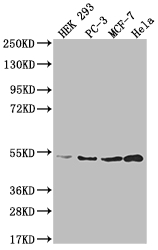Alternative Names
Adenosylhomocysteinase (AdoHcyase) (EC 3.3.1.1) (S-adenosyl-L-homocysteine hydrolase), AHCY, SAHH
Immunogen
A synthesized peptide derived from human AHCY
Immunogen Species
Homo sapiens (Human)
Purification Method
Affinity-chromatography
Concentration
It differs from different batches. Please contact us to confirm it.
Buffer
Rabbit IgG in 10mM phosphate buffered saline , pH 7.4, 150mM sodium chloride, 0.05% BSA, 0.02% sodium azide and 50% glycerol.
Tested Applications
ELISA, WB
Recommended Dilution
| Application |
Recommended Dilution |
| WB |
1:500-1:2000 |
Storage
Upon receipt, store at -20°C or -80°C. Avoid repeated freeze.
Lead Time
Basically, we can dispatch the products out in 1-3 working days after receiving your orders. Delivery time maybe differs from different purchasing way or location, please kindly consult your local distributors for specific delivery time.
Description
The production of the AHCY recombinant monoclonal antibody involves a well-structured process to ensure its quality and specificity. Initially, B cells are isolated from an immunized animal using a synthesized peptide derived from human AHCY as the immunogen. Subsequently, total RNA is extracted from the harvested B cells, and cDNA is synthesized through reverse transcription. The AHCY antibody genes are amplified using PCR with specific primers targeting the antibody constant regions and then cloned into an expression vector. This vector is transfected into host cells to enable the production of the AHCY recombinant monoclonal antibody. The antibody is harvested from the cell culture supernatant and purified using affinity chromatography to obtain a highly purified preparation. Rigorous characterization assays, including ELISA and WB analysis, are performed to confirm the specificity and functionality of the antibody, ensuring its ability to specifically recognize human AHCY protein.
Usage
For Research Use Only. Not for use in diagnostic or therapeutic procedures.




